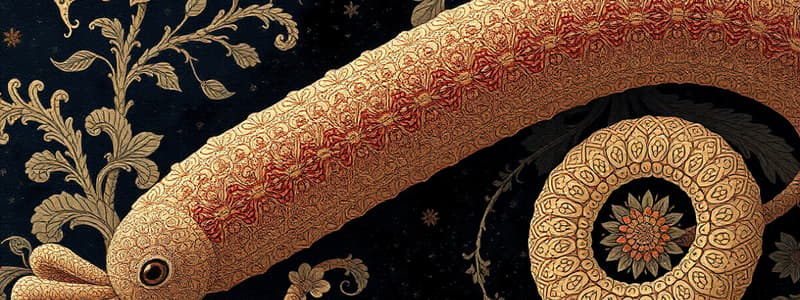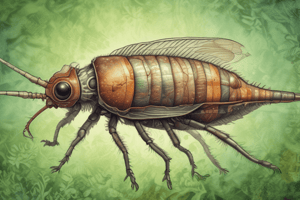Podcast
Questions and Answers
What is typically associated with the life cycle pattern of terrestrial parasites?
What is typically associated with the life cycle pattern of terrestrial parasites?
- Multiple intermediate hosts
- No intermediate host
- Single intermediate host (correct)
- Aquatic environments
What happens after the disintegration of the proglottids in the digestive tract of the host?
What happens after the disintegration of the proglottids in the digestive tract of the host?
- The eggs develop into adult worms
- The eggs are released into the water
- The oncosphere transforms into a cysticercus (correct)
- The proglottids are expelled from the body
Where are the cysticerci typically deposited in the intermediate host?
Where are the cysticerci typically deposited in the intermediate host?
- In the muscular parts of the body (correct)
- In the gastrointestinal tract
- In the respiratory system
- In the nervous system
Which of the following larval body plans is characteristic of terrestrial parasites?
Which of the following larval body plans is characteristic of terrestrial parasites?
What is the role of the scolex in the life cycle of a terrestrial parasite?
What is the role of the scolex in the life cycle of a terrestrial parasite?
What is a primary feature of Cestoda that differentiates them from other helminths?
What is a primary feature of Cestoda that differentiates them from other helminths?
In what way do cestodes reproduce?
In what way do cestodes reproduce?
Which type of life cycle characteristic is associated with Cestoda?
Which type of life cycle characteristic is associated with Cestoda?
What is the term used for the unique segments of a cestode that contain reproductive tissues?
What is the term used for the unique segments of a cestode that contain reproductive tissues?
Which of the following describes the scolex of cestodes?
Which of the following describes the scolex of cestodes?
Which statement best describes the reproductive strategy of Moniezia expansa?
Which statement best describes the reproductive strategy of Moniezia expansa?
What type of organisms serve as hosts for the larval stages of cestodes?
What type of organisms serve as hosts for the larval stages of cestodes?
What characteristic is NOT associated with the strobili of cestodes?
What characteristic is NOT associated with the strobili of cestodes?
What is protogyny in relation to reproductive organs?
What is protogyny in relation to reproductive organs?
What role does the cirrus play in the reproductive process?
What role does the cirrus play in the reproductive process?
Where are the oocytes fertilized in cestodes?
Where are the oocytes fertilized in cestodes?
What happens to fertilized eggs after they are formed in the ootype?
What happens to fertilized eggs after they are formed in the ootype?
What describes the release of terminal gravid proglottids?
What describes the release of terminal gravid proglottids?
Which term describes the excretion of empty proglottids mixed with feces?
Which term describes the excretion of empty proglottids mixed with feces?
What is a characteristic of the eggs formed by cestodes?
What is a characteristic of the eggs formed by cestodes?
What is the main function of the operculum in thick-walled, selectorized eggs?
What is the main function of the operculum in thick-walled, selectorized eggs?
Which larval stage is characterized by a transformation into a procercoid?
Which larval stage is characterized by a transformation into a procercoid?
What phenomenon occurs when proglottids are found in the intestine after fertilization?
What phenomenon occurs when proglottids are found in the intestine after fertilization?
What organisms primarily serve as the first intermediate host for many aquatic tapeworms?
What organisms primarily serve as the first intermediate host for many aquatic tapeworms?
In the life cycle of terrestrial parasites, what occurs in the hemocoele of the insect?
In the life cycle of terrestrial parasites, what occurs in the hemocoele of the insect?
What is the term for the six-hooked embryos found within eggs?
What is the term for the six-hooked embryos found within eggs?
What type of hosts do aquatic tapeworms typically target for the completion of their life cycle?
What type of hosts do aquatic tapeworms typically target for the completion of their life cycle?
Which of the following describes the condition the procercoid transforms into within its definitive host?
Which of the following describes the condition the procercoid transforms into within its definitive host?
Which is NOT true regarding the life cycle stages of aquatic parasites?
Which is NOT true regarding the life cycle stages of aquatic parasites?
Flashcards are hidden until you start studying
Study Notes
Cestoda
- Belong to the Phylum Platyhelminthes
- Parasitize fish, amphibians, reptiles, birds, and mammals
- Hermaphrodite
- Dorsoventrally flattened
- Have an indirect life cycle with 1 to 2 intermediate hosts
- Long patent period
- Lack a digestive system
- Body covered by an absorptive tegument
- Larval stages in intermediate hosts are called metacestodes
Two Main Groups
- Cestodaria:
- Not a significant group
- Have 10 hooks (decacanth)
- Eucestoda:
- Have only 6 hooks (hexacanth)
General Features
- Most cestodes consist of a scolex, neck, and strobila
- The entire worm behind the scolex is called the strobila
- Unique reproductive segments are called proglottids
- Proglottids are continuous with tissues throughout the body
- New proglottids form in the neck and move posteriorly
Scolex
- The scolex is the anterior end of the worm responsible for attachment
- Scolex morphology varies between species
- Scolex is typically equipped with hooks and suckers
Reproduction
- Most cestodes are monoecious
- Each proglottid contains one set of male and one set of female organs
- Self-fertilization is usually avoided due to protandry or protogyny
- Sperm transfer occurs between proglottids of the same or different strobila
Reproductive Organs
- Male:
- Testis
- Vas Deferens
- Seminal Receptacle/Vesicle
- Cirrus
- Female:
- Ovary
- Yolk Stock
- Ootype
- Mehlis' Gland
- Uterus
- Vagina
Egg Formation
- Oocytes are released from the ovary
- Oocytes are fertilized within the ootype
- Yolk cells are added to the zygote
- Fertilized eggs are released from the ootype into the uterus
- Gravid proglottids detach from the strobil and are expelled
- Different species release eggs in various ways:
- Apolytic: Proglottids break off before releasing eggs
- Pseudo-apolytic: Eggs are released in the gut, and proglottids are empty when expelled
- Eupolytic or Hyperapolytic: Proglottids detach in the gut after fertilization
General Life Cycle
- Aquatic Tapeworms:
- Eggs release an oncosphere or hexacanth
- Eggs or oncosphere are ingested by microcrustaceans or fish
- Oncosphere develops into a procercoid
- Procercoid transforms into a plerocercoid in the second intermediate host (fish)
- Terrestrial Tapeworms:
- Eggs are ingested by invertebrates like insects
- Eggs transform into a cysticercoid
- Cysticercoid awaits ingestion by the definitive host
Metacestodes
- Cysticercoid:
- Found in invertebrates
- Contains an invaginated scolex
- Cysticercus:
- Found in vertebrates
- Contains an invaginated scolex with a bladder
- Plerocercoid:
- Found in fish
- elongated and contains a cercomer tail
Studying That Suits You
Use AI to generate personalized quizzes and flashcards to suit your learning preferences.




